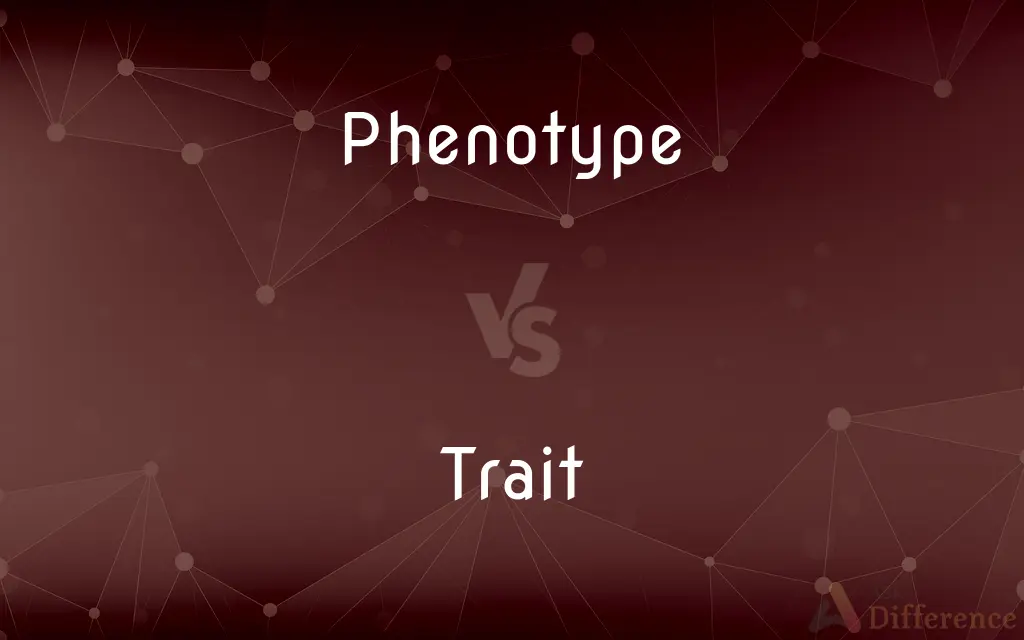Phenotype vs. Trait — What's the Difference?
By Urooj Arif & Fiza Rafique — Updated on April 14, 2024
Phenotype describes an organism's overall observable characteristics, resulting from genetic expression and environmental influences, while a trait refers to a specific feature or characteristic of an organism.

Difference Between Phenotype and Trait
Table of Contents
ADVERTISEMENT
Key Differences
Phenotype encompasses the total observable physical or biochemical characteristics of an organism, such as height and eye color, derived from both genetic makeup and environmental factors. Traits, on the other hand, refer to individual inherited features that are much more specific, like the color of one's eyes.
The phenotype of an organism includes multiple traits, illustrating a composite of all observable characteristics. Whereas a trait is a single element of this composite, such as the presence of freckles or curly hair.
Studying phenotypes allows researchers to understand the complexity of gene-environment interactions. In contrast, studying individual traits can help identify specific genetic influences and hereditary patterns.
The assessment of phenotypes is crucial in fields like medicine and agriculture for predicting disease susceptibility and breeding outcomes, whereas traits are often studied to understand particular genetic disorders or characteristics within a population.
Comparison Chart
Definition
The set of observable characteristics of an organism
A specific feature or characteristic
ADVERTISEMENT
Scope
Broad, encompassing multiple traits
Narrow, focused on one aspect
Influence
Genetic and environmental
Predominantly genetic
Variability
Can change with environment
Usually constant
Role in Genetics
Studied to understand gene-environment interactions
Studied to track inheritance and mutations
Compare with Definitions
Phenotype
Observable characteristics studied in genetics.
Researchers study phenotype to understand genetic expression.
Trait
Can be dominant or recessive.
Brown eye color is a dominant trait.
Phenotype
The overall appearance of an organism.
The phenotype of the plant included tall height and yellow flowers.
Trait
A specific genetic or observable characteristic.
Having blue eyes is a trait inherited from her parents.
Phenotype
Variable across different environments.
The phenotype of the butterfly changes with the seasons.
Trait
Influences the phenotype but is part of it.
A trait like leaf shape contributes to a plant’s overall phenotype.
Phenotype
The result of genotype and environmental interaction.
Nutrition affects the phenotype of height in humans.
Trait
Often used to study heredity.
Scientists track the trait of sickle cell anemia in populations.
Phenotype
A comprehensive expression of physical traits.
The dog’s phenotype features a black coat and blue eyes.
Trait
Stable and predictable in inheritance.
The trait for attached earlobes followed Mendelian inheritance patterns.
Phenotype
In genetics, the phenotype (from Greek φαινο- (faino-) 'showing', and τύπος (túpos) 'type') is the set of observable characteristics or traits of an organism. The term covers the organism's morphology or physical form and structure, its developmental processes, its biochemical and physiological properties, its behavior, and the products of behavior.
Trait
A distinguishing quality or characteristic, typically one belonging to a person
The traditionally British trait of self-denigration
Phenotype
The observable physical or biochemical characteristics of an organism, as determined by both genetic makeup and environmental influences.
Trait
A distinguishing feature, as of a person's character.
Phenotype
An individual or group of organisms exhibiting a particular phenotype.
Trait
A morphological, physiological, or behavioral feature of an organism.
Phenotype
The appearance of an organism based on a multifactorial combination of genetic traits and environmental factors, especially used in pedigrees.
Trait
(Archaic) A short line or mark made with a writing or drawing implement.
Phenotype
Any observable characteristic of an organism, such as its morphological, developmental, biochemical or physiological properties, or its behavior.
Trait
An identifying characteristic, habit or trend.
The number one personality trait I hate is hypocrisy. Why can't you be consistent!?
Phenotype
To evaluate or classify based on phenotype
Trait
(object-oriented) An uninstantiable collection of methods that provides functionality to a class by using the class’s own interface.
Traits are somewhat between an interface and a mixin.
Phenotype
What an organism looks like as a consequence of its genotype; two organisms with the same phenotype can have different genotypes
Trait
A stroke; a touch.
By this single trait Homer makes an essential difference between the Iliad and Odyssey.
Trait
A distinguishing or marked feature; a peculiarity; as, a trait of character.
Trait
A distinguishing feature of your personal nature
Common Curiosities
How do phenotypes differ from traits?
Phenotypes encompass all observable characteristics including multiple traits, while a trait is an individual characteristic.
Why study phenotypes in medicine?
Phenotypes help in understanding the potential health conditions a person might face based on observable characteristics.
Are all traits visible?
No, some traits, like blood type, are not visible and require testing to be determined.
What is a phenotype?
A phenotype is the complete set of an organism’s observable characteristics, which result from the interaction of its genetic makeup with the environment.
How are traits inherited?
Traits are inherited through genes passed from parents to offspring, following patterns observed by Mendel.
Can environmental factors influence traits?
While most traits are genetically determined, some, like height, can be influenced by environmental factors.
What role do phenotypes play in agriculture?
Phenotypes are critical in agriculture for breeding and selecting crops with desirable characteristics.
What is a trait?
A trait is a specific, inheritable characteristic of an organism, often identifiable and used to study genetics.
Can the same trait have different phenotypic expressions?
Yes, the expression of a trait can vary depending on genetic combinations and environmental conditions.
What is a polygenic trait?
A polygenic trait is one influenced by several genes, such as height in humans.
What is a simple example of a phenotype?
A simple example is the color and texture of a cat’s fur.
Share Your Discovery

Previous Comparison
Excellence vs. Mediocrity
Next Comparison
Contentment vs. JoyAuthor Spotlight
Written by
Urooj ArifUrooj is a skilled content writer at Ask Difference, known for her exceptional ability to simplify complex topics into engaging and informative content. With a passion for research and a flair for clear, concise writing, she consistently delivers articles that resonate with our diverse audience.
Co-written by
Fiza RafiqueFiza Rafique is a skilled content writer at AskDifference.com, where she meticulously refines and enhances written pieces. Drawing from her vast editorial expertise, Fiza ensures clarity, accuracy, and precision in every article. Passionate about language, she continually seeks to elevate the quality of content for readers worldwide.
















































